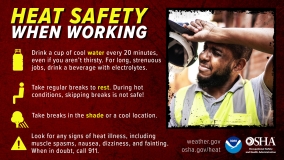Safety Talk With BJ
Safety Talk With BJ

Heat-Related Illness Awareness: A Summer Safety Reminder
Summer arrived in full force this year, bringing a wave of extreme temperatures. Many of us have already experienced days reaching into the 90s and 100s, with heat index values soaring well above 100 degrees due to the humidity. With this intense weather, awareness and prevention of heat-related illnesses have moved to the top of our safety priority list.
Just recently, two subcontractor employees experienced serious heat-related incidents on our jobsites. One passed out while performing strenuous labor and had to be transported by ambulance. After receiving IV fluids, cooling treatments, and rest, he was able to return to work the following day. In the second case, an employee who had likely overexerted himself over the weekend arrived at the site in good spirits but quickly collapsed due to severe dehydration. He also required medical attention and is expected to recover fully.
These incidents underscore a crucial point: once someone has suffered from a significant heat-related illness, they are much more susceptible to future episodes. A person who has experienced heat exhaustion or heat stroke is at greater risk of another episode in similar conditions, even if they believe they’ve fully recovered.
Heat exhaustion is serious but can often be managed without emergency medical assistance if cooling efforts are started quickly and symptoms begin to subside within 30 minutes. Common signs of heat exhaustion include feeling tired or weak, experiencing dizziness or a headache, feeling sick or actually vomiting, and sweating excessively. The skin may become pale and clammy, and some individuals develop a heat rash. Cramps in the arms, legs, or stomach may occur, along with rapid breathing or a fast heartbeat. A high body temperature and extreme thirst are also common symptoms. Children may show similar signs but could also become irritable.
If someone is showing signs of heat exhaustion, they should be moved to a cool, shaded, or air-conditioned place. Any unnecessary clothing, such as jackets or socks, should be removed to help the body cool down. They should slowly sip cool water or a sports drink to rehydrate. Cooling the skin with water and fanning them can help, and placing cold packs under the arms or on the neck is also effective. It’s important to stay with the individual and monitor them closely. They should begin to feel better within half an hour.
If they do not improve within 30 minutes, or if their condition worsens, the situation may progress into heatstroke. Signs of heatstroke include a very high body temperature, hot and dry skin that may appear red (though this can be harder to detect on darker skin tones), a rapid pulse, shortness of breath, confusion, loss of coordination, seizures, or loss of consciousness. In such cases, immediate medical attention is required. Call 911 and continue trying to cool the person down while waiting for emergency responders. If the individual loses consciousness, place them in the recovery position and stay with them until help arrives. Heatstroke is a severe medical emergency that cannot be treated without prompt professional care.
Preventing heat-related illness begins with good daily habits, especially during hot weather. It’s important to stay hydrated by drinking plenty of cool fluids, particularly when working or exercising outside. Wearing light-colored, loose-fitting clothing can help the body stay cooler. Limiting direct sun exposure during the peak heat of the day, typically between 11:00 a.m. and 3:00 p.m., is recommended. Avoiding excessive alcohol and extreme physical exertion during high temperatures can also reduce risk. If you are indoors on a very hot day, keeping curtains closed, turning off heat-producing lights and equipment, and avoiding opening windows when it’s hotter outside than inside can help maintain a safer indoor temperature.
These steps also help prevent dehydration, which is a major factor in heat-related illnesses. Individuals at greater risk include children, older adults, and those with long-term health conditions such as diabetes or heart problems.
Summer heat can be intense, but with the right precautions and an eye on each other’s well-being, we can all stay safe. Don’t ignore the signs, take action early, and remember that no job is worth risking your health.

